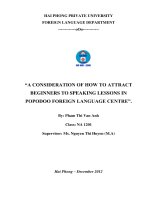Copy of How to Learn a Programming Language (any)
Bạn đang xem bản rút gọn của tài liệu. Xem và tải ngay bản đầy đủ của tài liệu tại đây (18.79 KB, 3 trang )
How to Learn a Programming Language (any)
1. Learn language basics
a. Variable Types
b. Operators
c. Basic input and output
d. Print something on STDOUT
e. Basic program structure
2. Learning out basic data structures / containers
a. Dictionary
b. Set
c. List
d. Array
e. That’s about it!
3. Learn basic file I/O
a. How to read a file in
b. How to write a file out
c. Crazy mileage ( simple -> complicated )
d. This goes from simple reading of a text file to….
DATABASE. Postgres, or mongodb (extremely
complicated)
4. Learn networking basics
a. Making HTTP requests with your language
i. Learn how to GET, POST, DELETE, etc.
requests.
ii. How to set your requests properly, how to
handle responses and status codes
b. Learn some basic socket programming your
language.
c. Overall, there are LIBRARIES out there to help
you to do this.
5. How to build your project and language
a. E.g. C++ you’ll have to learn how to build static
libraries, shared libraries, how to link your
applications properly.
b. E.g. Python developer. You’ll have to figure out
how to separate out your modules well.
i. Execution vs import style
ii. How does this is all fit into your project?
6. Learn OO / functional programming paradigm tools
a. E.g. for OO you need to learn how to use
classes, how to use inheritance, how to use
polymorphism, etc.
b. E.g. functional. You’ll have to learn how your
language uses blocks or lambdas, how function
pointers or callbacks work.
7. EXTRA Goodies in any language
a. Bag of trickies
b. You can come back to here and learn the
subtleties and nice stuff of any language
c. E.g. Ruby has a lot of cool methods on
enumerable types.









